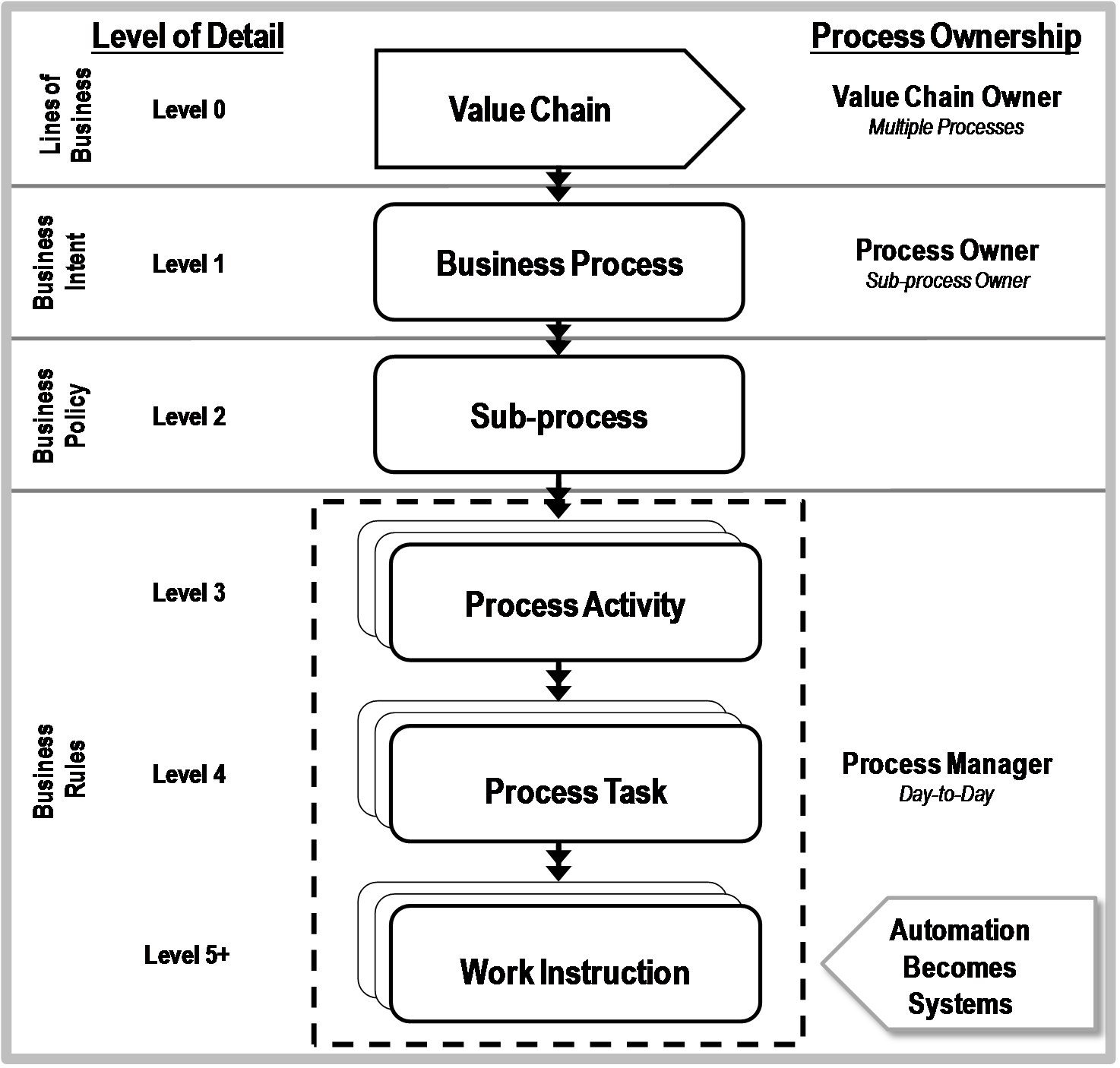Using Policies, Processes, and Procedures
The easiest way to think about Policies, Processes, and Procedures is in the level of detail contained within each item (Figure X-1). Processes can be described as being at a high level and operating across an organization’s various functions, whereas procedures are at a lower level and contain more detailed information, breaking down the various activities within a process.
 Figure X-1. Process map
Figure X-1. Process map
|
In simple terms, the primary difference between a process and a procedure is that a process is what you do and a procedure is how you do it.
Policies are at the macro level of detail and contain guiding principles or rules intended to influence decisions and actions carried out in Processes and Procedures. All are innately linked and, depending on the organization’s needs, may or may not be required in order to execute day-to-day activities or Process ImprovementOpens in new window efforts.
Processes are an excellent means of displaying a series of related activities in an easy to understand format; however in many cases they are deemed too high level for employees to use to perform their day-to-day tasks.
The most common solution to this problem is to pair process diagrams and procedural detail together, clearly detailing the steps in a process that a procedure refers to. By doing this, employees can see the greater context and implications of the cross-functional process while also having the level of detail required to successfully complete their duties.
When proper policies exist, everyone within an organization who is using different processes and procedures will be able to see the connection of what they are doing to why they are require to do so in a certain manner.
The most important element is that there is a cascading effect of improvements made at a higher level on those at a lower level. If a recommendation to replace a given Policy with a better one is made and accepted by business Process Owners, then corresponding changes in the subsequent Processes and Procedures must follow in order to ensure compliance.
Policies, Processes, and Procedures are all part of an organization’s Process Ecosystem and usually work best when all are managed together. Table X-1 outlines the distinguishing characteristics of a policy, process and procedure.
| Table X-1 | Distinguishing Characteristics of a Policy, a Process, and a Procedure | ||
|---|---|---|
| The distinctions commonly drawn between Policies, Process, and Procedures can be subtle, however, there are characteristics that help discern Policy from Process and Procedure. They are: | ||
| Policies | Processes | Procedures |
|
|
|
|
|
|
|
|
|
|
|
|
| Table X-1 Continues | ||
|---|---|---|
| Policies | Processes | Procedures |
|
|
|
|
|
|
|
|
|
|
|
|
|
|
|
|
|
|
Best Practices for Developing Policies, Processes, and Procedures
The following list describes best practices for developing and implementing Business Processes, Policies, and Procedures for use across an organization:
- Establish format, content, and writing standards for all three items
- Identify who will write, review, and maintain the documents
- Write Policies, Processes, and Procedures in separate documents
- Ensure each document is written with clear, concise, simple language
- Ensure documentation is easy to access, use, and update
- Setup common vocabulary to reduce confusion and ensure consistency of terms
- Use version controls to ensure proper document management
- Ensure subject matter experts are identified and readily available to resolve issues
- Develop each artifact with the customer and/or user in mind (internal or exrternal)
- Ensure each document does not include any unnecessary information
Benefits of Developing Policies, Processes, and Procedures
Development of Policies, Processes, and Procedures helps organizations:
- Provide visibility into areas of quality, productivity, cost, and schedule
- Improve communication and understanding
- Plan and execute activities in a disciplined fashion
- Capture lessons learned
- Facilitate the execution of organization-wide processes
- Analyze and continuously improve operations
- Reach new maturity levels
- Provide a basis for training and skills assessment
The series:
- Process Defined Towards Understanding Process Improvement Opens in new window
- Relationships among Policies, Processes, and ProceduresOpens in new window
- Using Policies, Processes, and Procedures Opens in new window
- Process Improvement DefinedOpens in new window
- Responsibilities of Process Improvement OrganizationOpens in new window
- Process Improvement Projects versus OperationsOpens in new window
- Role of a Process Improvement ManagerOpens in new window
- Research data for this work have been adapted from the manual:
- Tristan Boutros, Tim Purdie. The Process Improvement Handbook: A Blueprint for Managing Change and Increasing Organizational Performance.

